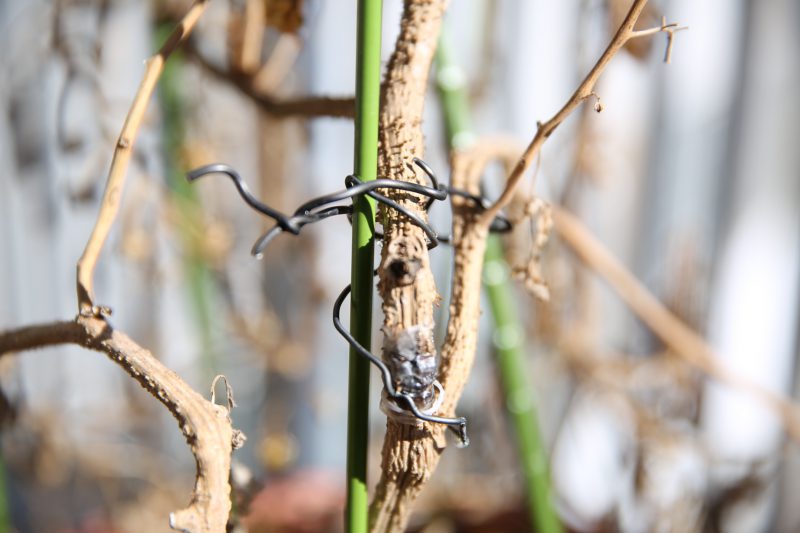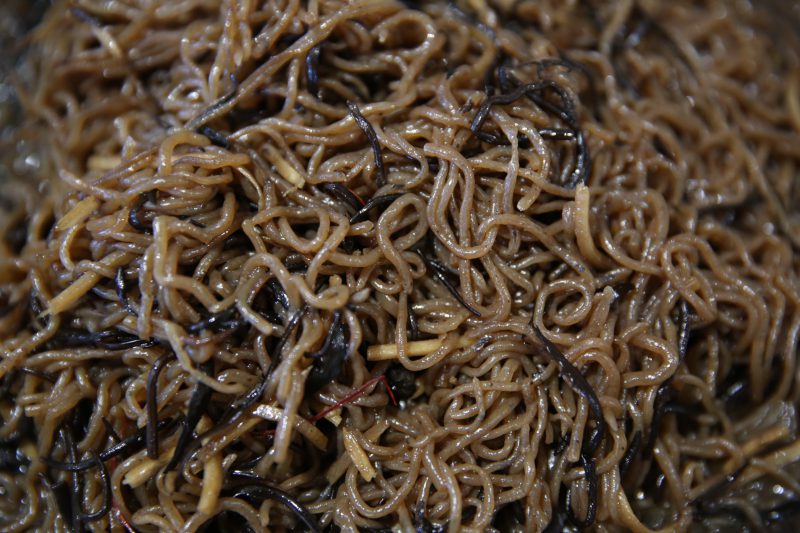niime 百科
Encyclopedia of niime
niime史 第2話
「オリジナリティ。」
niime History chapter 2
Originality
「オリジナリティ。」
Originality

2019 . 01 . 15
播州織による1点モノにこだわったモノづくり。今ではすっかりポピュラーになったtamaki niime独自のモノづくりの在り方だが、それを追求するに至った、ブランド立ち上げ時の想いと熟考。そして生き残ってゆくための方法論とは。
また、包み隠さずにLab内を見せるそのモノづくりは、顧客の確かな信頼を得ると同時に、せっかく構築してきた貴重なノウハウが流出しかねないリスクをも伴う。あえて「ガラス張り」を貫く玉木の決意とは。
tamaki niimeの根底にあるモノづくり思想、オリジナリティについての深い考えに触れる、「niime史」第2回。
掘り下げて播州織を知った上で、やろうと決めた。
私が最初に播州織をやりたいって思った時には、播州織というものにはどういう歴史があって、過去にどんな事を経てきて今があるのか?そして、これからどういう方向へと向かって行くのか?を理解しようと色々と調べた上で決めたんです。取り組み始めてからやっぱり違ってた、というのでは遅いし、そういう意味では、私はこれと思ったものは、最初にトコトン掘り下げるんですよ。何か、どうでもいいような些細な事まで(笑)。
本なども読んで調べて、自分の中で合点がいって納得したらやるし、違うこれじゃないと思ったら手を離すし、その作業ってすごく大事だと思っているから、ウチのスタッフにも、播州織はもちろんだし、tamaki niimeっていうのはどうなんだろう、どんな歴史があるんだろう?というのを、何となくではなく、しっかりと知っておいてもらった方が良いと思うんです。合わないなら合わないかもだし、それがはやくわかった方がいいと思うし。また、tamaki niimeのこれまでの歩みをお客様に伝える立場なら、それをより理解した上で伝えるのと、何も知らずに適当に話をするのとでは、お客様に伝わる重みが全然違うと思うから。
やっぱり、どういう意図があって私がこのブランドを立ち上げ、今に至ってるのかというところは知っておいてもらいたい。tamaki niimeの歴史を、ガチガチにじゃなく、その時々に私が聞いてもらいたいなと思うことを話して、少しでも腑に落ちてもらえたらと。
絶対に真似の出来ないモノを創る。
今のウチのモノづくりのシステムってすごく複雑だと思うんですよ、普通のブランドと比べると。一点モノしか作らないとか。シーズン性があるようでなくて、カタチをあまり変化させないとか。
なぜそうなったのか?というと、12年ほど前、私たちがまだ名前も売れてない頃、同じ様に無名で展示会に出してる人たちが大手ブランドから発注もらって大喜びしてる光景を観ていて。それから2、3シーズンくらいの間は発注が来てたのが、次のシーズンから急に来なくなって、何でだろう?と思ったら、実際はノウハウをパクられていて、その大手ブランドのオリジナル製品として出されていたという話を耳にしたんです。
もう“御用済み”で、後は自分たちでやれるからみたいな。デザインっていうものを簡単にパクるっていうのがけっこうアパレル業界で当たり前にあるみたいで、そういう現実を知らされると、絶対パクられないモノにしなくちゃいけないと思ったし、真似出来ないモノを創らなくちゃいけない、なおかつオリジナリティのあるモノでなければ、と考えたんです。
大手には出来ないことをやらないと生き残れない。
大手企業にはお金があって何でも出来るから、こっちは大手には出来ないことをやらなければ、私たちみたいなちっちゃな中小企業は生き残れない。すごく大きな、なんて言うのかな、「壁」みたいな感じ…それと立ち向かおうとしてる訳じゃないんだけど、大手とは異なる自分たちらしさみたいなものをしっかりと創らないと、パクッて食べられちゃうようではいけないって思ったの。今思うとそもそも、真似出来ないモノを創ろうっていう意思がすごく強かった。
あえて手間暇のかかるやり方を構築した。
だから普通のモノづくりをする人からしたら無茶苦茶面倒くさいことを、あえてしている。わざわざ10メートルで織機を止めて糸を変えてからまた織るとか。もちろん消費者目線で見ても一点モノが良いっていうのもあるんだけど、そういうやり方をすれば絶対真似出来ないだろうっていう持論はあったし、外注でそれが出来ちゃうとそこを押さえられたら終わりだけど、自社で構築すれば、と考えた。
真似するならどうぞ、でも無茶手間やで、っていう考えでこれまで創って来たというのが、今の私たちのカタチだと思ってるから、真似出来そうで出来ないってゆう、何とも複雑でグニョグニョした感じは、自分の中ではちょっと満足してる。
ガラス張りのモノづくりにして自らのハードルを上げる。
Lab見学もしてモノづくりを「ガラス張り」にする事には、真似されるかもという恐怖心もあったんだけど、そうしちゃう事で、自分のモノづくりのハードルを上げられるなと思ったの。
怯えるんじゃなくて、今創ったモノは、もう真似されてもいいよ、っていうスタンスで生きようと。明日また次の新しいのを考えるから、ってゆう。次次次って考えて、創り続ける。例えば店頭に出たモノを買われてパクられたとしたなら、買って頂いてるんだから文句は言えない。
そこを、何でパクるのよってブツブツ言うのも潔くないって思うから、パクれるもんならパクってみろ!くらいの気持ちでこっちはやらないと。そういう攻めの気持ちでやってるからこそ、真似出来ないんだと思うし。
放っといてもアイデアが無尽蔵に湧いてくるという訳では決してないからシンドイけど、そこは自分で自分のケツ叩く感じだよね。
私ひとりがずーっと考え続けるというのなら無理だろうけど、スタッフ皆んなのチカラを出して、それぞれの個性も掛け合わせて行けば、無限になり得ると思うんです。
書き人越川誠司
Her unique creative process working in Banshu-ori style has become very popular. Now that it is a well-known concept due to tamaki niime’s originality, we seek to understand her strategies and processes in trying to launch her name brand, as well as her thoughts.
Her upfront attitude in displaying her laboratory gained the trust of her customers, yet, at the same time, she risks an outflow of know-how. Why is Tamaki so determined to be so forward in being as open as possible in revealing the inner workings of her world?
In the second chapter of “niime history”, we delve deeper into her base philosophy into creation, originality and other deep musings.
After delving into Banshu-ori, we decided to proceed with our business.
When I began the concept of this business, I tried to understand what kind of history Banshu-ori has had, what past they have carried until now, and where it would go. After following all the facts, I decided to start this business, because I knew that if I started, and then found it wasn’t for me, it would be too late. That’s why I delved into it so much just to know a little information, even the unimportant facts. I read books to recheck it all, to persuade myself. I think this process is crucial for my staff, as well. I required them to know what Banshu-ori is, what ‘tamaki niime’ is, and what kind of history it has. I believed they should possess substantial knowledge about us, not just with feelings. If they find out they don’t like what we are, it’s better to know early on. When they explain it, if they can stand on a clear position to understand ‘tamaki niime’ and its history, then the customers understand the value and appreciate it more, compared to the staff feeling uncertain, unclear or drowning in irrelevant facts.
I would like them to know what has driven me to start this business and how we made it to this point. I would rather them to know our history at times in an easily understood fashion so that they can readily understand.
We would like to create something unique that no one can replicate.
I think our creative system is very complicated, compared with other brands. We make the ‘only one creation’. They look like seasonable products, but they are actually not, and the styles aren’t that different.
Let me tell you why we have chosen this way. The reason goes back 12 years when our name was not so well known. There were unknown creators, like us, that put their products in their exhibition, and they were so happy to get orders from a major company. They got orders next few seasons. After that, however, we found out there were no orders for them. We wondered why and heard that their technique and know-how had been stolen, and their products were sold as the dominant company’s original items. The creators were cut out because their role was complete. It was like “We can do it without you!” In apparel companies, stealing designs happens quite easily. Faced with that reality, we have come to determine that we must make the things nobody can copy, and creations have to have originality.
We cannot survive without doing something that major companies cannot do.
Major companies have vast amounts of funding to do anything, but as a small company, we cannot survive unless we do something that major companies cannot do. I don’t know how to say…well…there is a big wall facing us. We must have our uniqueness which differentiates us from major companies’; otherwise, we will be destroyed by them. As I think back then, I was more determined that we must make the things nobody can plagiarize.
I dared to take up a time-consuming and troublesome process.
With that said, you could claim that we have been creating our products in a manner that for those who are used to using more simplistic processes, is somewhat bothersome.
For example, we stop the weaving machine after working 10 meters, change thread and start weaving again. Of course, we are sure that the items are truly attractive to consumers, and we know that nobody can do it. However, if other companies can do it, it wouldn’t work for us. We have dared to go forward in this way. Our idea is like this, “Go ahead! If you
want to copy our style, but it is so very annoying.” I am satisfied with this complicated and contradictory way, which looks possible to copy, but it is incredibly vexing to do.
We are aiming high in showing our creation through glass windows.
We worried about being copied by displaying our laboratory in open tours and making our company accessible by showing it through glass walls. But I could aim high for my creations by doing so. Instead of having fear, I should stand firm to allow people to go ahead to try to plagiarize if they want to. It is all right to copy them which we have just made because we can make another one tomorrow. I should just aim for the next one and then another.
If someone bought our product at a store and copied it, I can’t complain because he or she bought it. If I complain about why they copy, I am not graceful. It would be best if you were ready for being copied. Nobody can copy me when I’m ready for their offence. It is not easy because creating ideas isn’t unlimited without effort. I have to kick myself behinds to push forward.
You could say it is impossible if I have to keep thinking of good ideas by myself. However, our staff tries to make it work, and with all our talents, it would be possible to make it endlessly.
Original Japanese text by Seiji Koshikawa.
English translation by Adam & Michiko Whipple.


